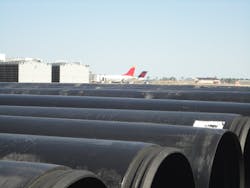Mississippi airport keeps operations running while repairing culverts
The Gulfport-Biloxi International Airport in Gulfport, Miss., was making improvements that included repairing, repaving and adding new runways and taxiways. During this improvement project, the airport discovered several aging and deteriorating drainage culverts under the existing runways/taxiways. The old reinforced concrete pipe (RCP) culverts were separating so the airport decided to also repair them while the improvement project was ongoing. Initially, the airport decided to fix two RCP culverts. One culvert was 950 ft long and had a 54 in. diameter and the other measured 550 ft long with a 48 in. diameter.
The airport decided to reline the 54-in. and 48-in. RCP culverts instead of replacing them. The engineering company on the project, Neel-Schaffer Inc., gave the main contractor, Hosea O’Weaver & Sons, an option to use either the Snap-Tite culvert lining system or cured-in-place pipe for the pipe repair.
The high-density polyethylene (HDPE) Snap-Tite pipe system has a patented male/female machining at each pipe section end. During installation, the machined sections are snapped together, piece by piece, and pushed into the full length of an existing pipe. Any annular space and voids between the old culvert and new liner are filled in with grout.
Hosea O’Weaver & Sons hired subcontractor Cambridgemoen LLC to handle the culvert-lining portion of the project. A benefit of relining the culverts with the HDPE, as opposed to re placing them, is that resurfacing runways and taxiways takes place alongside the culvert rehab without any disruption to the surface of the runways and taxiways. The airport continued to use the runways and taxiways for aircraft traffic while the relining took place.
“The main benefit of [HDPE pipe] is that the integrity of the pipe can be restored without any impact to the existing airport pavement, hence not causing airfield closings, disruption to airport users or affecting air traffic,” said Susana Cook, Neel-Shaffer engineer. “No significant economic impact is caused to airport operations.”
The pipe-relining phase of the project took less than a week to complete. For each of the culverts, the subcontractor slid one of the HDPE pipe sections inside the RCP and then snapped a second section to it using only come-a-longs and chains. This was done with each section until the pipe liner was fully in place inside the old RCP. Once the RCP was lined, the Cambridgemoen crew filled in any annular space between the RCP and HDPE pipe with grout, grouting the pipes in place.
